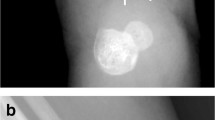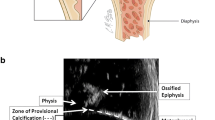Abstract
Background
Classic metaphyseal lesion (CML) is the term given to a fracture that most often occurs in the posteromedial aspect of the distal femur, proximal tibia, distal tibia, and proximal humerus in infants; this finding is strongly associated with non-accidental injury.
Objective
To demonstrate that the CML may occur following simple lower segment caesarean section (LSCS).
Materials and methods
A review of 22 years of an obstetric practice that delivers 8,500 babies per year.
Results
We identified three neonates born by elective LSCS, each with distal femoral metaphyseal fractures on postpartum radiographs. All caesarean sections were elective and uncomplicated. External cephalic version was not employed preoperatively. Postpartum radiographs demonstrated a fracture of the distal femoral metaphysis in each neonate, typical of a CML.
Conclusion
We propose that a CML can occur in the setting of a simple, elective and uncomplicated LSCS where no external cephalic version is employed.



Similar content being viewed by others
References
Caffey J (1957) Some traumatic lesions in growing bones other than fractures and dislocations: clinical and radiologic features. Br J Radiol 30:225–238
Kleinman PK, Marks SC, Blackbourne B (1986) The metaphyseal lesion in abused infants: a radiologic-histopathologic study. AJR 146:895–905
Kleinman PK, Marks SC (1998) A regional approach to the classic metaphyseal lesion in abused infants: the distal femur. AJR 170:43–47
Cumming WA (1979) Neonatal skeletal fractures. Birth trauma or child abuse? J Can Assoc Radiol 30:30–33
Ehrenfest H (1922) Birth Injuries of the child. Appleton-Century-Crofts, p 208
Camus M, Lefebvre G, Darbois Y et al (1985) Traumatismes obstetricaux du nouveau-ne. Enquete retrospective a propos de 20409 naissances. J Gynecol Obstet Biol Reprod (Paris) 14:1033–1044
Curran JS (1981) Birth-associated injury. Clin Perinatol 8:111–129
Kleinman PK (1998) Diagnostic imaging of child abuse, 2nd edn. Mosby, St Louis, p 219
Lysack JT, Soboleski D (2003) Classic metaphyseal lesion following external cephalic version and cesarean section. Pediatr Radiol 33:422–424
Carty H, Pierce A (2002) Non-accidental injury: a retrospective analysis of a large cohort. Eur Radiol 12:2919–2925
Kleinman PK, Marks SC, Blackbourne BD et al (1995) Inflicted skeletal injury: a postmortem radiologic-histopathologic study in 31 infants. AJR 165:647–650
Lonergan GF, Baker AM, Boos SC et al (2003) From the archives of the AFIP. Child abuse: radiologic-pathologic correlation. Radiographics 23:811–845
Kleinman PK, Nimkin K, Spevak MR et al (1996) Follow-up skeletal surveys in suspected child abuse. AJR 167:893–896
Nadas S, Gudinchet F, Reinberg O et al (1993) Predisposing factors in obstetrical fractures. Skeletal Radiol 22:195–198
Author information
Authors and Affiliations
Corresponding author
Rights and permissions
About this article
Cite this article
O’Connell, A., Donoghue, V.B. Can classic metaphyseal lesions follow uncomplicated caesarean section?. Pediatr Radiol 37, 488–491 (2007). https://doi.org/10.1007/s00247-007-0445-x
Received:
Revised:
Accepted:
Published:
Issue Date:
DOI: https://doi.org/10.1007/s00247-007-0445-x




